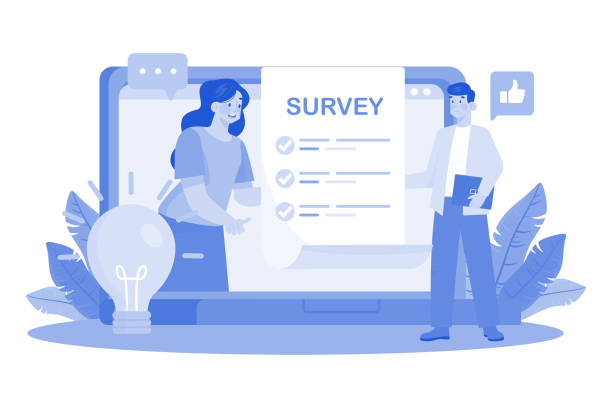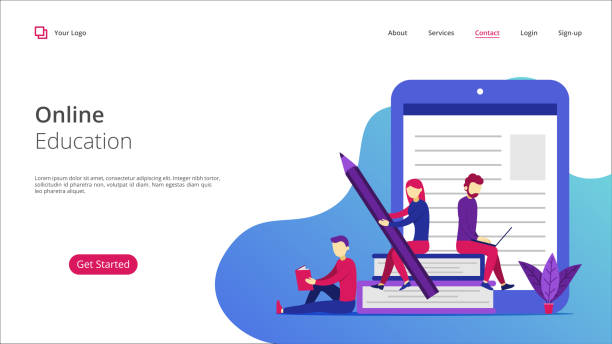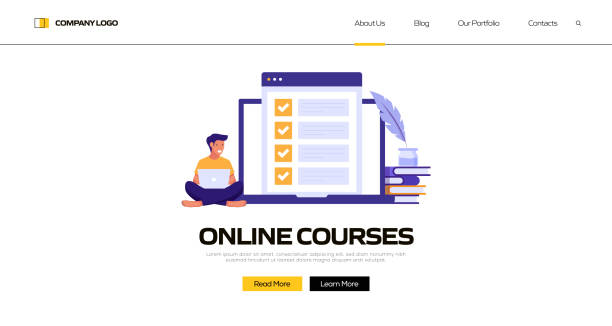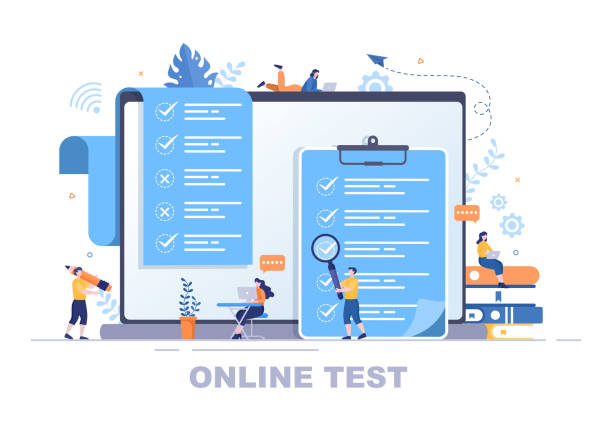Introduction to User-Friendly Website Design

In today’s digital world, merely having a website is not enough; your website must be designed in a way that users can easily interact with it and have a pleasant experience.
This is where the concept of #User_Friendly_Website_Design becomes important.
User-Friendly Website Design means creating a website that is not only visually appealing but also provides visitors with easy navigation, quick access to information, and a friction-free experience.
This approach is the core of any successful digital strategy, as it directly impacts conversion rates, user time spent on the site, and even your search engine rankings.
A poorly designed website can quickly dishearten users and drive them towards competitors.
Therefore, investing in user-friendly website design is not just a choice, but a necessity.
This process involves a deep understanding of user needs and behaviors, applying appropriate visual and functional design principles, and continuous optimization based on feedback.
The importance of this issue is such that many successful businesses allocate a significant portion of their digital marketing budget to improving user experience and user interface design (UI/UX).
In this comprehensive article, we will delve into various aspects of user-friendly website design and provide practical solutions for its implementation, so that your website is not only seen but also remembered by users.
Are you frustrated with the low conversion rate of your online store?
Rasaweb provides the definitive solution with professional e-commerce website design!
✅ Increase your sales and revenue
✅ Unparalleled user experience for your customers
⚡ Get a free consultation now!
The Importance of User Experience (UX) in Website Success

User Experience or UX is the backbone of a user-friendly website design.
UX is not limited to the appearance of a website; rather, it includes all aspects of user interaction with the site, from entry to exit.
An excellent user experience allows users to easily find what they need, enjoy navigating the site, and ultimately achieve their goals (such as making a purchase, signing up, or finding information).
This directly affects the Bounce Rate, which is the percentage of visitors who view only one page and then leave the site.
Websites with poor UX have high bounce rates, which means losing potential customers.
In contrast, an optimized user experience increases user time on the site, boosts interaction, and improves conversion rates.
This means more profitability for your business.
Also, search engines like Google consider user experience factors in ranking websites.
Websites that offer a better user experience are more likely to appear higher in search results.
This issue further clarifies the importance of specialized attention to UX.
To design a user-friendly website, you need to empathize with your users and look at the website from their perspective.
This includes conducting user research, creating personas, mapping user journeys, and user testing to identify pain points and continuously improve.
Ultimately, focusing on UX means not only enhancing a website but also building a strong bridge between your business and your customers.
Basic User Interface (UI) Principles for Ease of Use

User Interface or UI refers to the visual look and feel of a website that the user directly interacts with.
While UX deals with the overall user experience, UI focuses on visual elements such as colors, fonts, buttons, icons, and how they are arranged on the page.
A good UI helps users easily navigate the site and feel comfortable with it.
Adhering to key UI principles is vital for achieving a user-friendly website design.
These principles include simplicity and clarity, consistency, visual feedback, visual hierarchy, and accessibility.
Simplicity and clarity mean that the design should be free of clutter and complexity, and information should be presented clearly and understandably.
Consistency refers to the uniformity of design elements throughout the website; for example, buttons and forms should always be in the same style and location so that the user is not confused.
Visual feedback means that when a user performs an action (e.g., clicks a button), the site should provide a visual response so that the user knows their action was successful.
Visual hierarchy also helps organize information so that the most important elements stand out.
All these principles ultimately lead to a common goal: creating a smooth and predictable interactive experience for the visitor.
These principles not only contribute to aesthetic appeal but also significantly increase the efficiency and usability of the website.
Correct application of these principles in web design assures users that they can effortlessly achieve their goals on the site.
Here is a table of key UI principles:
| Principle | Explanation | Application Example on Website |
|---|---|---|
| Simplicity and Clarity | Removing unnecessary elements and presenting information clearly | Concise navigation menus, readable fonts, use of white space |
| Consistency | Maintaining uniformity in layout, color, font, and element placement | Identical color and shape for “Add to Cart” buttons on all product pages |
| Visual Feedback | Providing visual response to user actions | Button color change on click, “Successfully Sent” message after form submission |
| Visual Hierarchy | Organizing elements by importance to guide user’s eye | Larger headings for main sections, use of prominent colors for Call to Action (CTA) |
| Accessibility | Designing for all users, including people with disabilities | Alt text for images, appropriate color contrast, keyboard navigation |
Responsive Design and Mobile-First Approach

In the current era, where mobile device usage for internet access has become widespread, Responsive Design and the Mobile-First approach are of high importance and are considered cornerstones of user-friendly website design.
Responsive design means creating a website whose appearance and functionality automatically adapt to the screen size of the user’s device (whether computer, tablet, or mobile).
This means users will have an optimal visual and functional experience on any device they use.
Without responsive design, mobile users may encounter issues such as very small text, unclickable buttons, or inappropriate images, which quickly leads to loss of visitors.
The Mobile-First approach goes even further; in this approach, website design and development begin with mobile devices, and then gradually scale up for larger screens like tablets and desktops.
The reason for this approach is that designing for smaller screens forces designers to focus on essential content and critical functionality, which itself helps eliminate unnecessary elements and create a simpler, more efficient experience.
Google has also emphasized the importance of mobile compatibility for years and considers it a significant factor in website rankings.
Therefore, if you are looking to improve SEO and provide a user-friendly website design for all your users, implementing responsive design and adopting a mobile-first approach is inevitable.
This approach ensures that your website is accessible and enjoyable for the vast majority of today’s users.
Is your e-commerce site ready to attract maximum customers and increase sales? Rasaweb transforms your online business with modern and efficient e-commerce website designs.
✅ Increased speed and improved SEO
✅ Excellent user experience on mobile and desktop⚡ Get a free e-commerce website design consultation from Rasaweb!
Content Strategy for User Attraction and Retention

Content is king, but not just any content; content designed to attract and retain users.
Alongside a user-friendly website design, a strong content strategy can make a crucial difference in user experience.
Your website’s content should not only be informative and relevant but also presented in a way that engages users and encourages them to stay and explore further.
This includes using simple and understandable language, short paragraphs, bullet points, and engaging images and videos to break up text monotony.
Furthermore, content structure is very important; using clear headings and subheadings, lists, and tables can aid content readability and scannability, which is vital for today’s hurried users.
Call-to-Actions (CTA) should be clearly defined and appealing to encourage users to take the next step.
Do you want users to fill out a form, make a purchase, or subscribe to your newsletter? The CTA should show them the way.
Additionally, content should answer potential user questions and address their needs.
FAQ sections, blogs with specialized articles and guides, can all help strengthen this aspect.
Entertaining and analytical content can also help increase user time on the site and improve the overall experience.
With a powerful content strategy aligned with your user-friendly website design, you will not only attract more traffic but also convert that traffic into loyal customers.
Optimizing Loading Speed and Performance

Website loading speed is one of the most important factors in user-friendly website design and also in search engine rankings.
Research has shown that users expect a website to load in less than 3 seconds, and if there is a delay, many will leave the site.
This means losing business opportunities and increasing bounce rates.
Therefore, optimizing loading speed is not just an SEO technique, but directly impacts user experience.
Several factors affect loading speed, including image size, unoptimized coding, server and hosting selection, and the use of heavy plugins.
To increase speed, the first step is compressing images without significant loss of quality.
Using next-gen image formats like WebP can be very effective.
The second step is to optimize CSS, JavaScript, and HTML codes by removing white spaces, comments, and redundant code.
Using a Content Delivery Network (CDN) can also help distribute your website content across various geographical servers and reduce response time for users in different parts of the world.
Also, choosing a reputable and high-speed hosting provider, and using caching to temporarily store website data in the user’s browser, can help speed up page loading on subsequent visits.
Continuous monitoring of website speed with tools like Google PageSpeed Insights and GTmetrix is essential to identify and resolve bottlenecks.
Remember that a fast website not only keeps users satisfied but also encourages them to stay longer and explore more on your site, thereby directly helping to achieve the goals of user-friendly website design.
Accessibility Considerations for All Users

Web Accessibility means designing and developing websites in a way that people with different abilities (including people with disabilities) can easily use them.
This is a vital aspect of user-friendly website design that is often overlooked.
Accessibility is not only an ethical and social responsibility but can also significantly expand your target market.
A website that is accessible to everyone will be usable by millions of people, including those with visual, auditory, motor, or cognitive impairments.
Implementing accessibility principles includes many items.
For example, using Alt Text for images, which helps Screen Readers describe image content for blind individuals.
Ensuring sufficient color contrast between text and background for people with low vision, providing captions for videos for deaf individuals, and allowing full website navigation using only the keyboard (without needing a mouse) for individuals with motor disabilities, are among these.
Also, using semantic HTML structure and correct form labeling helps screen reader users better understand information.
The Web Content Accessibility Guidelines (WCAG) provided by the World Wide Web Consortium (W3C) specify best practices for achieving web accessibility.
Ignoring accessibility can lead to losing a large portion of the audience and even legal issues.
Therefore, any business seeking a user-friendly website design and comprehensive approach should place accessibility at the core of its design and development process.
Below is a table of accessibility considerations and their importance:
| Consideration | Importance for User | How to Implement |
|---|---|---|
| Alt Text for images | Helps blind individuals understand image content through screen readers | Adding concise and useful descriptions in the alt attribute of the <img/> tag |
| Sufficient Color Contrast | Ensuring text readability for people with visual impairments (color blindness, low vision) | Using contrast checker tools to select appropriate colors |
| Keyboard Navigation | Enabling website use without a mouse for people with motor disabilities | Ensuring logical tab order, ability to focus on all interactive elements |
| Captions and Transcripts for Audio/Video Content | Accessibility for deaf or hard-of-hearing individuals | Providing SRT/VTT files for videos and full text for podcasts |
| Accessible Forms | Ensuring all users can fill out and submit forms | Using appropriate labels, clear error messages, and input validation |
User Testing and Continuous Improvement

After designing and launching a website, the work is not over.
User Testing and continuous improvement are integral parts of the user-friendly website design process.
No matter how user-friendly you think your website is, real users always exhibit behaviors that may not have been anticipated.
User testing involves observing users as they interact with your website to identify weaknesses, navigation problems, and confusions.
This can be done through in-person tests, remote tests, or even by using tools that record mouse movements and user clicks.
The feedback collected from these tests is invaluable and provides the necessary basis for website improvement.
In addition to qualitative user testing, you can also use A/B testing.
In A/B testing, two different versions of a page or an element (such as button color, title, or layout) are shown to different groups of users to determine which version performs better.
This data-driven approach helps you make more optimal decisions for improving the user experience.
Also, continuous monitoring of website statistics with tools like Google Analytics is very important to identify user behavior patterns, pages with high bounce rates, or incomplete conversion paths.
User-friendly website design is not a static process, but an iterative cycle of design, implementation, testing, and improvement.
By committing to this approach, your website will constantly evolve and provide the best possible experience for your users.
Research shows that 80% of customers trust companies with a professional website more. Does your current site earn this trust?
With Rasaweb’s corporate website design services, solve the problem of customer distrust and a weak online image forever!
✅ Create a professional image and increase customer trust
✅ Attract more sales leads and grow your business
⚡ Get a free consultation
Common Website Design Mistakes and How to Avoid Them

Even with the best intentions, designers and developers can make mistakes that harm the website’s user experience.
Recognizing and avoiding these common mistakes is an important part of user-friendly website design.
One of the biggest mistakes is over-complexity.
Trying to put too much information or too many features on one page can confuse users.
Simplicity and minimalism are often the best solutions.
Another mistake is unclear or inconsistent navigation.
If users cannot easily move around your site and access what they need, they will quickly leave.
Clear menus, appropriate internal links, and a logical page structure are essential.
Neglecting responsive design is also a big mistake; as mentioned earlier, ignoring mobile users means losing a large portion of your audience.
Low-quality or inappropriate images, unreadable fonts, and unsuitable color combinations can also damage the visual experience.
Also, ignoring Call-to-Actions (CTA) or hiding them among a plethora of text means users won’t know what the next step is.
Slow loading speed, which we discussed earlier, is also a common and fatal mistake.
Using intrusive and unnecessary pop-ups that disrupt the user experience should also be minimized.
The absence of a search capability or poor search on large sites can frustrate users.
Finally, not updating content and outdated design can make your site look unprofessional.
By avoiding these mistakes and focusing on user needs, you can achieve a user-friendly website design that is not only beautiful but also efficient and successful.
The Future of User-Friendly Website Design

The world of the web is constantly evolving, and user-friendly website design is no exception.
The future of the web is moving towards more personalized, interactive, and intelligent experiences.
One of the main trends is Artificial Intelligence (AI) and Machine Learning (ML) in optimizing user experience.
These technologies can analyze user behavior and dynamically adjust website content or layout based on individual preferences.
For example, websites can suggest more relevant products or display more suitable articles based on a user’s browsing history.
Voice User Interfaces (Voice UI) are also growing and will soon become an integral part of the web, especially with the increasing popularity of voice assistants like Siri and Alexa.
This necessitates optimizing content for voice search and designing efficient voice interactions.
Augmented Reality (AR) and Virtual Reality (VR) also hold great potential for creating immersive web experiences, particularly in areas like online shopping and tourism.
Furthermore, the focus on sustainable and green website design, which reduces energy consumption, will become more important with increasing environmental awareness.
Finally, data security and privacy will continue to be major user concerns, and user-friendly website design must include robust solutions for protecting personal information.
To keep pace with these changes and maintain user-friendly website design in the future, businesses and designers must constantly be learning, experimenting, and adapting.
Embracing new technologies and listening to changing user needs will be key to success in the future web landscape.
Frequently Asked Questions
And other services of Rasa Web Advertising Agency in the field of advertising
- Smart Brand Identity: A combination of creativity and technology to increase sales through precise audience targeting.
- Smart Google Ads: Professional optimization for campaign management using real data.
- Smart Marketing Automation: Professional optimization for customer acquisition using attractive UI design.
- Smart Brand Identity: A creative platform to improve click-through rate with attractive UI design.
- Smart Website Development: A creative platform to improve sales with custom programming.
And over hundreds of other services in the field of internet advertising, advertising consultation, and organizational solutions
Internet Advertising | Advertising Strategy | Advertorials
Sources
UI/UX Design Principles Comprehensive Guide to User-Friendly Website Design HTML/CSS Website Design Tutorial UX Design Principles
? Rasaweb Afarin, a leading digital marketing agency, paves the way for your business success. From professional e-commerce website design to comprehensive SEO strategies, we are ready to distinguish your brand in the online space and take it to the top.
📍 Tehran, Mirdamad Street, next to Central Bank, Kazeroon South Alley, Ramin Alley No. 6


